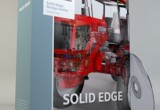More Success with Swoosh: Caprock Manufacturing
Online, November 14, 2011 (Newswire.com) - Founded in 1983, Caprock Manufacturing (Caprock) is a privately held custom manufacturer of plastic injection molded products and assemblies for original equipment manufacturers (OEMs) in the medical, utilities, transportation, energy and other industries. Vertically integrated services include product design, prototyping, mold making and a wide range of finishing processes. Caprock's enclosures business unit designs and manufactures casings for airline signage, water meters, electrical enclosures, durable medical equipment and other products.
Caprock excels in early supplier involvement, a process in which it partners with customers during the product design period to ensure manufacturability, quality and cost effectiveness while keeping tooling lead-time to a minimum. This simplifies the design process and has proven to be much more efficient for all parties than the conventional customer approach of bringing the job out for bid only after the
design is finalized and then finding manufacturability issues during the tooling process.
More demand on engineering group
Understanding its success in the market, Caprock kept its focus on the design process and, in 2011 under the guidance of Swoosh Technologies, decided to upgrade its computer-aided design (CAD) tools from SolidWorks® software from Dassault Systemes SolidWorks Corporation to Solid Edge® software from Siemens PLM Software. Caprock had used SolidWorks for six or seven years, selecting it because it was an industry trend. "But we read press and blog posts that SolidWorks was going to a new modeling kernel and that prompted us to look at the market," says Joshua Walles, a senior project engineer with Caprock.
"Our concerns about the future of SolidWorks actually led us to the discovery of a major shift in CAD innovation and productivity," notes Walles. "The synchronous technology in Solid Edge proved to be the
answer to the increased demand here on our engineers."
As a contract manufacturer, Caprock works with its customers to modify and redesign parts for product manufacturability. Most of the company's engineers have no formal CAD training and are dual-tasked with project management duties.
"We weren't really entrenched in the complex design planning process using SolidWorks," says Walles. "The feature-tree parametric process has been a real time consumer. We struggled with history based modeling. It was like a tough chess game; you would have to look five, six, seven, eight, ten moves ahead in the future in order to get the design right."
"SolidWorks is not as evolved as Solid Edge is," says Walles. "Using SolidWorks, the design is only as sound as the feature tree is. If you discover a mistake made earlier, in many cases just forget it, you might as well start over."
Time for a new CAD technology evaluation
Caprock performed a basic market search, looking at its existing SolidWorks and Pro/Engineer® software. "Initially, we were leery of keeping SolidWorks, because of the uncertainties in its future direction and lack of new innovation in the past few releases," says Walles.
That led Caprock to Solid Edge and the discovery of an unexpected bonus in synchronous technology. Often, Caprock has only a paper drawing from its customers or sometimes a dumb solids file. Walles points out that bringing in a dumb solid with SolidWorks would be just the same as having a standard for the exchange of product model data (STEP) equivalent: "I don't have time to recreate all the features that require modification."
Editing CAD data with synchronous technology became a key interest point for Caprock. "What would take us several hours to edit in SolidWorks takes us less than an hour using Solid Edge," says Walles.
Using Solid Edge, changes made by Caprock no longer require recreating the feature tree. "With synchronous technology, you just delete or modify the design feature and go," says Walles. "That makes it a very forgiving design tool. The software is more intuitive and we don't have to guess what the programmer's intent was to use most common software features."
Caprock reports significant error reduction since moving from SolidWorks to Solid Edge. "I need to draw as fast as I think. The number of mistakes is much, much less than it used to be," says Walles, a Swoosh Technologies's customer.
"Over a period of a year, I might have 20 customer redesign projects and would have to start all over in about 10 of them using SolidWorks due to a combination of lack of familiarity and fighting with the
design plan," says Walles. "With Solid Edge and synchronous technology, that rarely happens. Yes, I would call Solid Edge and its synchronous technology a breakthrough - true innovation."
Contact Swoosh Technologies today to learn how a kernel change to Solid Edge will improve your capabilities and secure the future of your CAD drawings.

